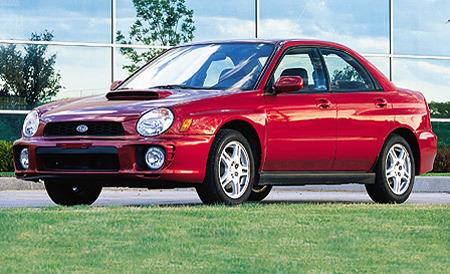If you haven’t yet heard of the Subaru Impreza WRX, you’re reading the wrong magazine. For years, the turbocharged hot-rod sedan was sold in Europe and Japan but not here. Then when Subaru unveiled its new Impreza, the WRX version was finally offered to U.S. customers.
We didn’t hesitate to heap copious amounts of slobbering, unbridled praise on it. The WRX immediately won a place on our 2002 10Best list. When we went to include it in a comparison test, we found there were no other cars that matched its combination of low base price ($24,520), four-wheel drive, and punchy 227-hp turbocharged engine. So we hauled in two ringers that cost almost double: the Audi S4 and the BMW 330Xi. The Subaru finished second behind the Audi and damn near won the thing. After that, only one question remained: Would the WRX keep us charmed over 40,000 miles?
To find out, Subaru sent us a 2002 WRX sedan without any options. In hindsight, we probably should have gotten the more practical wagon version that costs $500 less than the sedan. But we had plenty of sport-utes around to haul our junk and didn’t want the wagon’s extra weight diminishing the fun.
Our long-termer was the third WRX to undergo our testing procedures. If slow in this case is a relative term, our long-termer was the slowest of the three. The quickest WRX we’d tested hit 60 mph in a stunning 5.4 seconds, whereas our new baby needed 5.9. It trailed that primo WRX by a similar amount in every acceleration test, but the long-term car strangely had the highest top speed of the three, 145 mph. Perhaps our testing shoe was a bit off that day.
None of the staff seemed to mind that the times were off, however. If Michigan’s flat, straight roads can lull us into the driving doldrums, the WRX, or Rex as it came to be known, became our favorite tonic. In the car’s first 500 miles, the praise had already started. “This is unquestionably the best combination of fun and inconspicuous packaging on the market today,” noted one editor.
After only three weeks and 3000 miles of driving, we brought the car in for its first scheduled service, an oil and filter change, which cost a very reasonable $24. After that, the owner’s manual called for an oil-and-filter change and tire rotation at 7500 miles and every 7500 miles thereafter.
The most expensive service was the 30,000-mile one that set us back $295. It called for replacement of the coolant, brake fluid, and air and fuel filters in addition to the regular oil change and tire rotation. During that service we also had the transmission and differential fluids changed, procedures that are recommended by the manual but not mandated. The total cost for six services was $566. By comparison, our long-term Volvo S60 T5’s service stops (August 2002) cost $599.
The WRX also had an unplanned visit to the dealer. At 31,971 miles, the check-engine light came on. Loose gas caps can trigger warning lights, so we tightened ours, but the problem persisted. The dealer discovered that the wiring harness was pinched and causing certain electrical connectors to intermittently lose contact, which tripped the warning light. The car was fixed in a day, and the cost was covered by the WRX’s three-year/36,000-mile warranty.
One thing we should note about the warranty: Subaru says it “excludes damage resulting from participation in competition or racing events.” That’s a reasonable clause, but the WRX comes with a free, yearlong membership to the Sports Car Club of America (SCCA). Among the numerous events the SCCA hosts is the Solo II autocross in which unmodified street cars run through a low-speed cone course (max speed is less than 60 mph). These courses are usually set up in parking lots, so there’s nothing to run into and the cars go through one at a time.
Isn’t it safe to assume that a few WRX owners will appreciate the SCCA membership and try out a relatively harmless autocross? Probably. If you’re one of them, be wary, as we’ve heard stories of dealers not honoring warranties if the car has been autocrossed.
Although we never entered any competition events with our car, it took a beating anyway. Daily commutes became foot-to-the-floor qualifying sessions. “This car wants to be driven very aggressively,” wrote one editor. In addition, we used the WRX for our test of aftermarket brake systems (“Shedding Light on Fading Brakes,” September 2002).
So we weren’t surprised when, at the end of our test, the WRX was showing signs of wear, particularly in the transmission. At 30,000 miles, downshifting from second to first gear at piddling speeds resulted in an occasional and discomforting crunch, which grew more frequent as the miles piled on. At the 40,000-mile mark, the crunch occurred about half the time we went for first gear. Still, it didn’t warrant a new gearbox, if indeed that was the culprit.
At least the car’s performance held up over its stay. When we performed final testing at 40,000 miles, the 60-mph sprint equaled the car’s time when it was new (5.9 seconds). All other acceleration numbers were within a 10th or two of a second. Top speed fell 6 mph to 139, and the worn Bridgestone tires could only manage 0.79 g on the skidpad, a 0.02 drop from the maiden test.
That distressing tranny noise and the one instance with the check-engine light were the only niggles, and they didn’t lessen our enthusiasm. The cheering persisted even at the 38,727-mile mark, when techie Markus opined, “Still ranks as the best car in the fleet for discreet hurrying.”


Leave a Reply